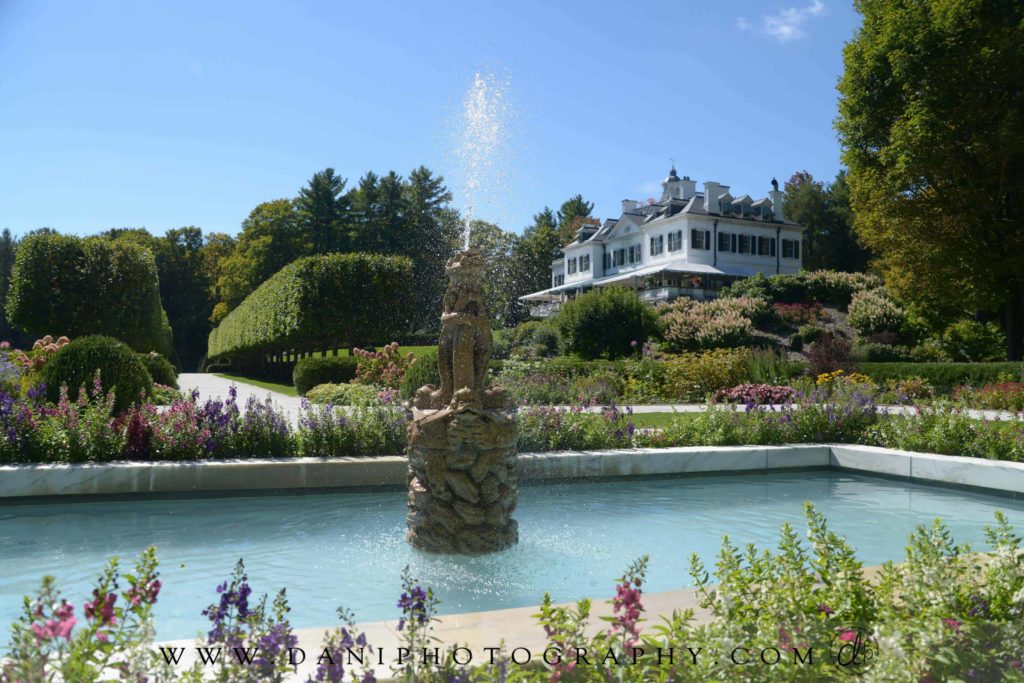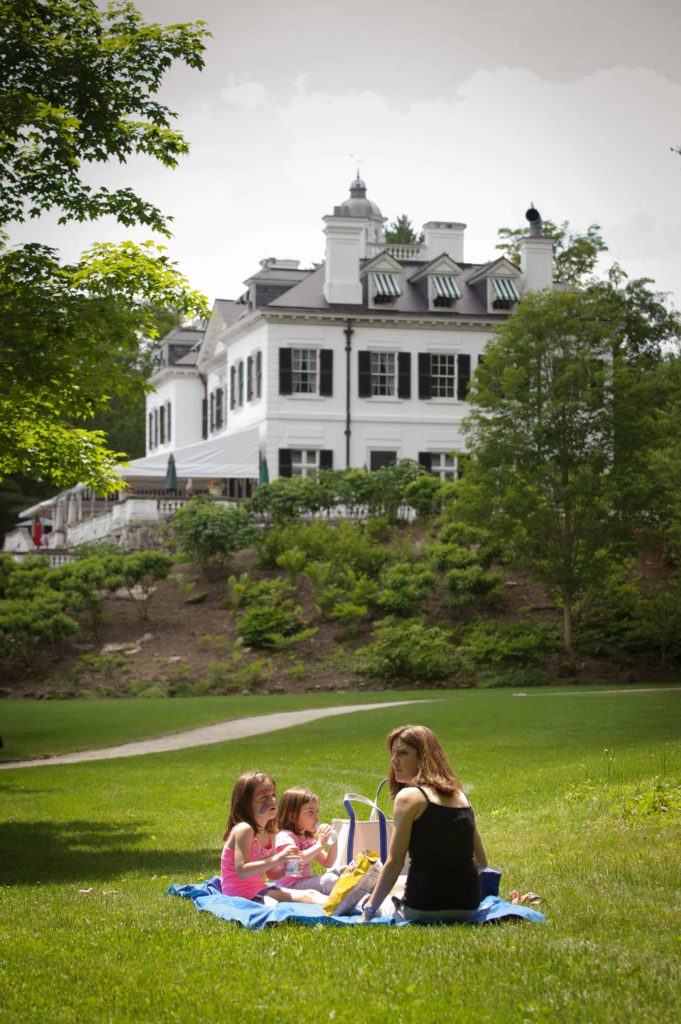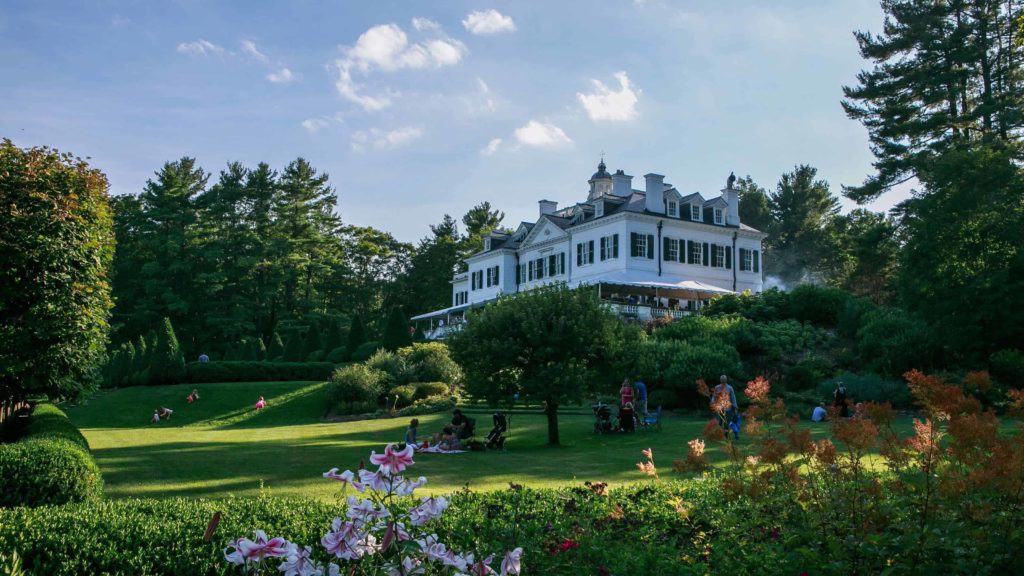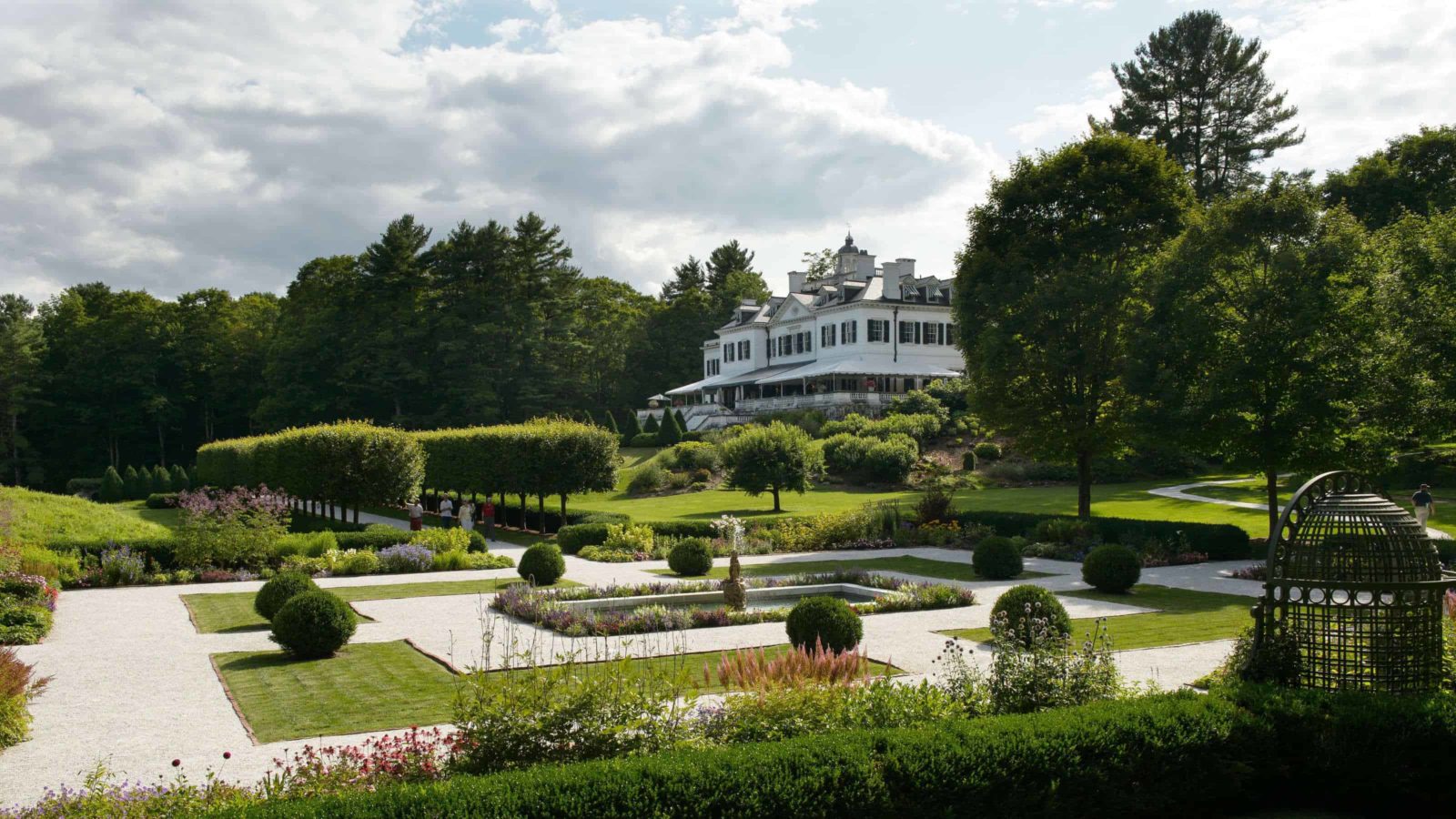2020 has been a year of powerful forces in the U.S., with the upcoming presidential election, the pandemic, its resulting economic downturn, and a powerfully impactful nation-wide protest movement.
A hundred years ago, Edith Wharton looked at a world shaken by war, pandemic and economic collapse. And this summer, writers and readers around the world are finding her work timely.
This year, The Mount, Edith Wharton’s Berkshire historic house and gardens, is celebrating the centennial of The Age of Innocence, the novel that made Edith Wharton the first woman to win a Pulitzer Prize in fiction.
The novel follows Newland Archer, a young man in an elite family of 1870s New York City as he navigates relationships with two women, May Welland, who has grown at the center of his elite New York, and her cousin, Ellen Olenksa, bright and honest, who returns to New York from a brutal marriage with knowledge of the wider world. Paralyzed by indecision, Newland is torn between tradition and desire.
A hundred years later, Wharton’s writing inspires novelists, scholars, and journalists, and at the Mount contemporary writers are sharing their experiences with the book with a worldwide audience. In the pandemic, the Mount has moved much of their summer programming online, as novelists, journalists, and nonfiction writers talk about their own new work and Wharton’s influence. A virtual exhibit, “Writing The Age of Innocence,” offers a behind-the-scenes overview of Wharton’s writing process and the conditions under which the novel was written, and its critical reception.
The exhibit’s curators, Director of Visitor Services Anne Schuyler, and her colleague Nick Hudson, Research Assistant, sat down on a summer day to talk (virtually) about The Age of Innocence and its resonance today.
Julia: Where is Edith Wharton coming from when she’s writing The Age of Innocence?
Anne: Well that’s a really good question and one we had fun trying to find out about, because we think of it today as one of her greatest works, so she must have thought about it a lot and worked on it a lot, but it comes right on the heels of World War I, and she’s really busy in World War I. She’s very much involved in charity and humanitarian work
And (after the war) she’s writing up a storm. It’s contradictory … on the one hand she says that it’s hard for anyone to write about the war, because it’s changed everything and the world is so different. On the other hand, she’s writing so much—she called it like a fever, a writing fever, at one point.
So she’s writing nonfiction work, and she’s writing In Morocco, a travel work. … And she was writing a war novel called A Son at the Front. She had a contract and everything for it with a magazine, The Pictorial Review, for serialization and then they told her, ‘well, we don’t want a war novel. War novels are dead in America and we don’t want them. What we really want is a House of Mirth-type book,’ because The House of Mirth was perhaps still her most well known book and had been a bestseller.
[Wharton] started writing The Age of Innocence, and she finished it in less than 7 months. It was amazingly rapid paced for writing a novel. So you almost get the idea that it was an accidental masterpiece, because she was really writing it at speed.
‘Yes, she’s writing about the 1870s, but what she’s saying is still very relevant. Contemporary authors are still finding a lot of what’s still relevant in her books, so her reputation is much revived.’
Paris was loud. It was noisy, it was modern, it was full of Americans, and so she moved 20 miles north of Paris … in 1919.And then she also rented a villa down in the south of France on the Riviera called Castel Sainte-Claire.
And both of them needed a lot of money to fix up, so she needed money. And so she was writing what she hoped would be a lucrative novel. She hoped that she could pay some of these bills for renovating her houses. … That was the best thing about The Age of Innocence, she said at one point. It’s kind of funny — you get the idea that she never thought it was one of her best novels.
Julia: It seems like Ellen Olenska and Edith Wharton share their unhappy marital past and also the societal double standards that women are forced to bear the brunt of. I was curious whether you have any thoughts about that, or if there are any opportunities Ellen Olenska has in the novel that Edith Wharton herself did not have.
Anne: Wharton probably had more options than Olenska had, because Wharton could write her way out of a lot of problems.
She could earn money by writing, and Ellen Olenska had no way of making money other than her relatives. So she either had to please her grandmother, or she had to go back to her apparently abusive husband.
But often when people look at this novel they ask the question “Who is Edith Wharton in this novel?” and you can make the case that Edith Wharton is all of these characters. There are parts of Wharton that are in Newland, and there are parts of Wharton in Olenska.
Olenska has the European perspective that Wharton has adopted, and the love of European life, the cultural life, the artistic life, the relative freedom. Because Ellen gets freedom. She doesn’t get total freedom, and she doesn’t get love, so to speak, at least not with Newland. We don’t know what happens to her in Europe, but …
Nick: I always wonder about that to be honest.
Anne: I know … Some nice handsome Frenchman somewhere.
She gets financial support from her relatives. She’s not rich, but she’s certainly not well off. She gets support, and she gets freedom.
And Wharton found that in France as well. Wharton had to write for it, she had to keep writing, and she spent more money too. She had two houses and she had servants and she had cars, so she lived on a much larger scale than Olenska probably did …

The dolphin fountain plays in the gardens at The Mount, Edith Wharton's historic house in Lenox.
Nick: Anne and I definitely have different readings of [May], but at least on the most basic level you definitely can see that May is the type of woman that Edith’s mother wanted her to be.
Anne: Yeah, Edith Wharton probably grew up with a lot of Mays, and so she’s channelling a lot of that into the character of May and the whole society.
Nick: And she does write about that in A Backward Glance, I think. Going to Newport, seeing all the handsome men and beautiful women, especially the beautiful women on the lawns doing archery, and things like that.
Anne: Yeah, and I think it’s in A Backward Glance where Wharton says, which I always draw comparisons with today as well, that you had to be a beautiful woman or a handsome man, or society really didn’t care about you … She wouldn’t have called herself a great beauty.
Nick: Yeah, but she was very big into clothes.
Anne: One of the joys of reading Wharton for me is … how good she is at describing clothes, and not just because she likes clothes, but because they’re part of the character, and they’re describing the character.
Before the pandemic hit and we had to take our exhibit online, we were planning a live, physical exhibit in the rooms at the Mount, and we wanted to depict Ellen Olenska in her drawing room in this robe that was perfectly described, a fur-lined robe that was fur against skin. It was all very sensual language….
But that image, that visual was so Olenska, it was like ok she’s exotic, she’s not like all the rest of the women of that time. She’s not afraid to wear fur on skin, and this just mesmerizes Newland, of course, it just intoxicates him, and Wharton is so good at that. She’s so good at those kinds of details.
Nick: I think it’s now one of my favorite Wharton books, Katherine Joslin’s Edith Wharton and the Making of Fashion, cause, I mean, clothes and fashion just pop up in so much of her work, and reading that book, I don’t think, I don’t think about clothes or fashion very much to be honest, but it put it all in sort of a new light to me.
Anne: No I think it’s all on purpose. Wharton, a line from The Age of Innocence is “it’s a hieroglyphic world” and that’s how she uses fashion as well. It’s hieroglyphic, it has meaning, it all has meaning and it’s up to the reader to try to figure that out which makes it more fun I think.


Julia: I would love to hear more about both of your readings of May.
Nick: Yeah, I’m convinced she’s the hero of the book, obviously once you read the book you realize she’s really the one with all the agency. Newland doesn’t know what’s going on — even by the end of the book, I’m not sure he really knows what went on, what happened. He thinks that May died thinking everyone was good and the world was great, and that doesn’t seem accurate.
She also seems to have a larger imagination than he does. For instance when he goes to Florida, she very much gives him a way out, and I think he just recoils. He can’t imagine not following sort of like the standard script, so he doesn’t. He just restates his vows and says he really loves her, and he traps himself.
And again, this is maybe slightly more risky, he’s very concerned with shaping her, but as soon as she tries to give her own opinion about books or literature or things like that, he’s not interested at all. So I don’t know. I mean, if there’s a tragedy, part of me feels like it’s the tragedy that May ended up with Newland.
Anne: And I would argue that she’s probably perfectly happy with him, because she got what she wanted, and I think the thing with May is, if you read the historical criticisms of the book, May is sometimes depicted sometimes very one-dimensionally. She’s the catalyst that makes the story end like it does, and it’s really just about two people, and it’s not about three people. But you know that’s part of Newland, because you see most of the book through Newland’s eyes, and Newland underestimates her. We learn that later — as the reader, you learn that May really knows much more than Newland thinks she does.
But I always argue (that) she is bound by the values of society that she represents, and so she’s the tug and pull on one end, and Ellen Olenska is the tug and pull on the other end, and Newland is caught in between. And because he, ultimately, can’t break the bounds of convention, he’s trapped in a way.
But then a lot of Wharton characters get trapped like that. They don’t want to betray what they see as their own moral sense. And so they betray other parts of their character, of their being. If you look at it from the perspective, did everybody get what they wanted and get what they deserved, so to speak, Newland got a conventional, successful life … He didn’t experience the heights of love and passion, but other than that he had a pretty good life. And he could still have this dream. He could still have this vision of Ellen, and this great love that didn’t happen. But in one sense it’s better that it didn’t happen, because it stays perfect in that way, it stays unsoiled by everyday life …
In her notes there are sketched out a couple of different versions of the plot, and they involve having the relationship, and going off to the place in Florida. One version has them getting married. And another version has them having an extramarital affair, and neither of them can stand it. Ellen Olenska wants to go back to Europe, she misses Europe, and Newland can’t stand it — he’s going against his own moral sense, and he wants to get back to New York.
So, instead of this tragedy of them being broken up by other forces, they both say ok, we’re done. In one version they stay married—Ellen’s in Paris and he’s in New York and they have this sort of platonic marriage, so you know, she was playing around with different versions of it, but she landed on and decided on the unconsummated relationship, which makes it a very different novel, I think, than if they had actually consummated (a marraige) and just got bored with each other. But they had different values, and that comes out.
Julia At the beginning of the book, Newland Archer says that women ought to be free, as free as we are. Does that align with Edith Wharton’s thinking?
Anne: Well, in one sense … he was talking about the freedom to divorce. This is what he says, and I think what he wants to believe, but when it actually comes to the requirements of his family and all the social conventions and everything, of course he’s the one that tells Ellen Olenska you can’t possibly get a divorce because it will hurt your whole family, and that starts that whole thing in motion.
Wharton herself got a divorce in 1913, and I’m sure she was glad to get that divorce. Wharton wanted economic and social freedom, and sexual freedom. In a lot of her books, she’s got this sort of simmering anger, and not always simmering, about the sexual inequality of women and the economic inequality of women.
It doesn’t necessarily translate into political power though. She was not a suffragist. She was not a supporter of the suffrage movement. She wasn’t an active anti-suffragist; she just held herself aloof. She wasn’t involved publicly in either pro- or anti-suffrage, and one of the reasons for that, we think, is that she wanted to be an artist, and she wanted her work to be judged on its artistic and literary merit. She didn’t want her name mixed up in social causes of the day. She didn’t like being called a lady writer or a woman writer. She just wanted to be a writer, or an artist and an author.
So she railed against being categorized, and in that sense she was very much like Willa Cather, who was her contemporary and the only American woman writer at that time that still has the same stature. … Cather didn’t want to be seen as a woman writer and didn’t want to be associated with a lot of the political causes. So I would say yes, Wharton definitely felt that women should have the same power and stature, but that wasn’t necessarily a political thing.

Families picnic on the lawn on a summer evening at the Mount, Edith Wharton's historic house in Lenox.
Julia: You also write in the exhibit that her reputation fluctuated in the decades immediately following her death. Could you talk a little bit about that?
Anne: Well she died in 1937, and then I would say in the 1940s and the 1950s, and some of the 1960s, there was the whole wave of literary criticism and authorship, and she was [seen as] a relic of a lavender age, and not at all relevant. And it wasn’t just (Wharton) — it was other women as well … authors of that age.
And cold, that was one of the criticisms of her, that she was always so cold and unemotional … It’s very unfair. She was criticized for not being a womanly enough writer, and then also criticized for being a woman writer, so she got both ends of it. And by not being feminine enough (they meant) that her characters were cold, some of them. She didn’t go into the melodramatic pathos of some of her contemporary writers. She didn’t like that.
With Wharton it’s always about what’s unsaid — you have to read between the lines, because that’s what she thought real life was like, and in some sense that’s what her characters would have done. …
Ironically, it wasn’t until the 1970s when a discovery was made that she had an affair with this man named Morton Fullerton, and her letters were found, and a whole new biography started of Wharton with a new look into her life and a much more rounded character.
At the beginning of the feminist movement she was seen as a feminist icon, and that was probably going too far one way as well.
And she’s become much more relevant, and today, as we say in the exhibit, there are all kinds of people who point to her.
Yes, she’s writing about the 1870s, but what she’s saying is still very relevant. Contemporary authors are still finding a lot of what’s still relevant in her books, so her reputation is much revived.
Nick: I’m not sure she always helped herself. One reason she fell out of fashion is she was seen as mostly writing about the wealthy.
Anne: Yes, because she was going against the grain at the time. (People said) that the only authentic story was what she called “the man with the lunch pail,” which was what she called the working class. And she said authentic stories can happen anywhere. … She had some stories about people that included different levels of society, but her main subject was the upper classes or the middle classes, and she felt that was just as valid, because they had stories and issues as well.

Fall color touches the hedges and the lake shore at The Mount, Edith Wharton's historic house in Lenox.

